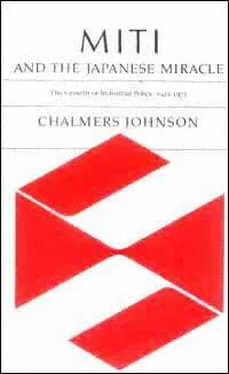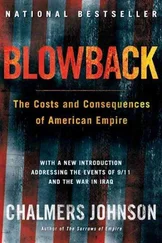Chalmers Johnson - MITI and the Japanese miracle
Здесь есть возможность читать онлайн «Chalmers Johnson - MITI and the Japanese miracle» весь текст электронной книги совершенно бесплатно (целиком полную версию без сокращений). В некоторых случаях можно слушать аудио, скачать через торрент в формате fb2 и присутствует краткое содержание. Год выпуска: 2007, Издательство: Stanford University Press, Жанр: Старинная литература, на английском языке. Описание произведения, (предисловие) а так же отзывы посетителей доступны на портале библиотеки ЛибКат.
- Название:MITI and the Japanese miracle
- Автор:
- Издательство:Stanford University Press
- Жанр:
- Год:2007
- ISBN:нет данных
- Рейтинг книги:3 / 5. Голосов: 1
-
Избранное:Добавить в избранное
- Отзывы:
-
Ваша оценка:
- 60
- 1
- 2
- 3
- 4
- 5
MITI and the Japanese miracle: краткое содержание, описание и аннотация
Предлагаем к чтению аннотацию, описание, краткое содержание или предисловие (зависит от того, что написал сам автор книги «MITI and the Japanese miracle»). Если вы не нашли необходимую информацию о книге — напишите в комментариях, мы постараемся отыскать её.
MITI and the Japanese miracle — читать онлайн бесплатно полную книгу (весь текст) целиком
Ниже представлен текст книги, разбитый по страницам. Система сохранения места последней прочитанной страницы, позволяет с удобством читать онлайн бесплатно книгу «MITI and the Japanese miracle», без необходимости каждый раз заново искать на чём Вы остановились. Поставьте закладку, и сможете в любой момент перейти на страницу, на которой закончили чтение.
Интервал:
Закладка:
28
Meanwhile, on July 18, 1962, Sato* Eisaku resigned as MITI minister, and Prime Minister Ikeda appointed Fukuda Hajime to replace him. Fukuda was a classic politician of the party-men's factions, a former war correspondent (Singapore) and chief of the political department of the Domei News Agency, a five-times-elected member of the House of Representatives from Fukui prefectureand a stalwart of the Ono* faction. Ikeda named him on the recommendation of Ono, whose support he needed to hold off the political challenges coming from both Sato and Kono* Ichiro*. Fukuda was exactly the type of man whom the elite bureaucrats of MITI wouldand didderide as a "small-time politician," but he will never be forgotten within the ministry as the cause of the "Fukuda typhoon" of July 1963.
During June 1963 Vice-Minister Matsuo Kinzo* was preparing for his amakudari as director (later vice-president) of Nippon Kokan*. He recommended to Minister Fukuda that Sahashi be named as his successora change of command that had been long and carefully planned. However, on July 1, 1963, Fukuda was involved in a wide-ranging discussion with a group of journalists, during which one of them said, "Various personnel matters are pending within MITI.
Page 262
Could you tell us about them?" "Certainly," replied Fukuda. "Since MITI is an agency that serves the public, the fact that Sahashi has gotten a bad reputation with industry makes him unsuitable. I think that Imai would be good. I intend to appoint him as the next vice-minister."
29
The ensuing explosion within MITI has become legendary. All work stopped. Just as at the time of the military mutiny in 1936, officials met in groups according to their entering classes to caucus on this unprecedented development. Some were quoted in the next day's newspapers as asking, "How is it that a party-politician minister, who knows nothing about the traditions of our glorious MITI, can pick a vice-minister we don't like?" The press club commented sardonically that the bureaucratic
amai seikatsu (la dolce vita
) at MITI had come to an end. And the public was confused: it thought that the minister always chose his own top subordinates, at MITI and at other ministries. Some cooler heads remarked, "Of course the minister technically has the final say in personnel matters. Both Sahashi and Imai are OK, and except for the fact that Sahashi has developed a faction within the ministry, neither can change MITI as a whole." Thus was born the "Sahashi faction"and its opposite number, the "international faction," which would take over the ministry in 1966. The press coverage of the ''Fukuda typhoon" effectively diverted attention from the Special Measures Law in the Diet and raised enough questions about its author to cause it to become "sponsorless legislation."
The reasons for Fukuda's action are not hard to find. First, as a party politician in a party increasingly dominated by former bureaucrats, Fukuda wanted to put the bureaucrats in their place. He was often quoted as saying, "It is sheer arrogance that some bureaucrats want to usurp the authority of politicians." Second, both the Maruzen affair and the Special Measures Law had made the business world nervous about a restoration of bureaucratic controls over the economy. Fukuda's action reassured business leaders on this score, since Imai was not only a champion of liberalization but had also won the trust of the prime minister and was the son-in-law of Yamazaki Taneji, president of the Yamazaki Securities Company. Third, LDP insiders believed that there was a link between Sato* Eisaku and Sahashi, and this was something Fukuda's faction leader, Ono* Bamboku, wanted severed.
The MITI elders were called in to try to control the damage. Outgoing Vice-Minister Matsuo advised Sahashi to keep his mouth shut while they worked out a solution. Sahashi made it clear that even though he and Imai were both from the class of 1937, he would not
Page 263
resign as custom would normally have dictated. The result was a ceremonial meeting, presided over by the great senior Shiina Etsusaburo *, in which it was decided that Imai would become vice-minister, Sahashi would take Imai's old job at the Patent Agency, Imai would hold the top spot for only a year (he actually stuck it out for 15 months), and Sahashi would succeed him. Sahashi has written that this affair was his most unpleasant experience in 30 years of government service, and one can believe him. Nonetheless, he did have the satisfaction of seeing his ideas for the economy accepted and implemented, even if he and his law were none too popular.
30
Throughout this period foreign pressure on Japan to speed up liberalization increased in intensity. At the first Joint Meeting of Economic Ministers of Japan and the United States at the end of 1961, the Americans asked for a faster pace of liberalization than the 80 percent Ikeda had promised; and in September 1962 the IMF recommended a level of 95 percent (the IMF and Japan compromised on 90 percent). Then, on February 20, 1963, the IMF Board of Directors met, rejected Japan's stated reasons for not having shifted to article 8 status, and insisted on a pace of liberalization greater than 90 percent. Japan really had no choice if it intended to continue to participate in international trade. It therefore gave notice that it would formally become an article 8 nation on April 1, 1964, and would simultaneously stop rationing foreign exchange through MITI-controlled budgets.
Pressure from GATT also developed. Before the British would sign a basic treaty of commerce and navigation with Japan, they insisted that Japan accept article 14 of GATT (no governmental subsidies of exports); and Japan's acceptance of IMF article 8 was tantamount to adhering to GATT's article 11 (no trade controls because of balance of payments deficiencies). Therefore, with its ratification on April 4, 1963, of the Anglo-Japanese treaty, Japan notified GATT that within a year it would shift to article 11 status. During July 1963 Japan also applied for membership in the Organization for Economic Cooperation and Development (the first Asian nation to do so), and it was admitted on April 29, 1964but with some seventeen temporary reservations to the OECD's code of behavior for members. Nonetheless, membership in the OECD meant that Japan was committed not only to trade liberalization but also to the removal of controls on capital transactions. The "fully opened economy" was at last on the nation's agenda.
Simultaneously with the acceptance of these new international obligations, the economy itself began to decline into its worst postwar recession. During October 1964, the same month that Sahashi replaced
Page 264
Imai as vice-minister, the recession began. At first it looked like a normal cyclical downswing caused by a balance of payments crunch and government controls on credit, a type of recession that Japan had experienced several times since the Korean War. However, on December 1, 1964, the Japan Special Steel Company declared that it was bankrupt and applied to the courts for relief under the Company Reorganization Law (Kaisha Saisei Ho *). On March 6, 1965, the Sanyo* Special Steel Company followed suit, announcing that it could not cover its debts of some ¥50 billion. This was the biggest bankruptcy that had yet occurred in postwar Japan. Two months later the Yamaichi Securities Company reported that it too was unable to meet its debts and was going under; it was saved only by a drastic, government-secured loan program. Finally, in June and July the government abandoned its sixteen-year policy of balanced budgets and began to issue bonds to cover deficit financing of counterrecession expenditures. Fiscal policy had finally replaced Japan's long reliance on monetary policy alone.
Under these circumstances analysts began to argue that this was not a "normal" recession but instead a "structural recession" caused by the "distortions" of high-speed growth. The structural recession thesis was associated above all with economists around Prime Minister Sato*, who replaced Ikeda in November 1964, and with MITI.
Читать дальшеИнтервал:
Закладка:
Похожие книги на «MITI and the Japanese miracle»
Представляем Вашему вниманию похожие книги на «MITI and the Japanese miracle» списком для выбора. Мы отобрали схожую по названию и смыслу литературу в надежде предоставить читателям больше вариантов отыскать новые, интересные, ещё непрочитанные произведения.
Обсуждение, отзывы о книге «MITI and the Japanese miracle» и просто собственные мнения читателей. Оставьте ваши комментарии, напишите, что Вы думаете о произведении, его смысле или главных героях. Укажите что конкретно понравилось, а что нет, и почему Вы так считаете.












